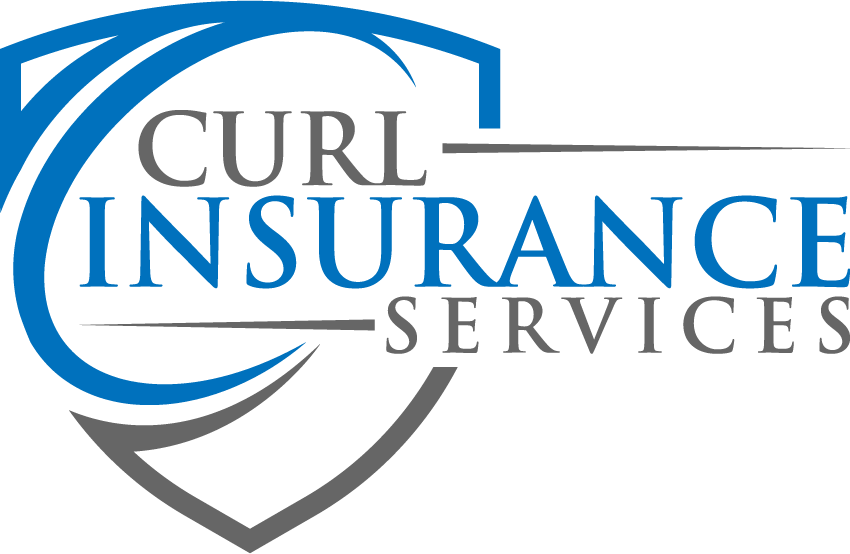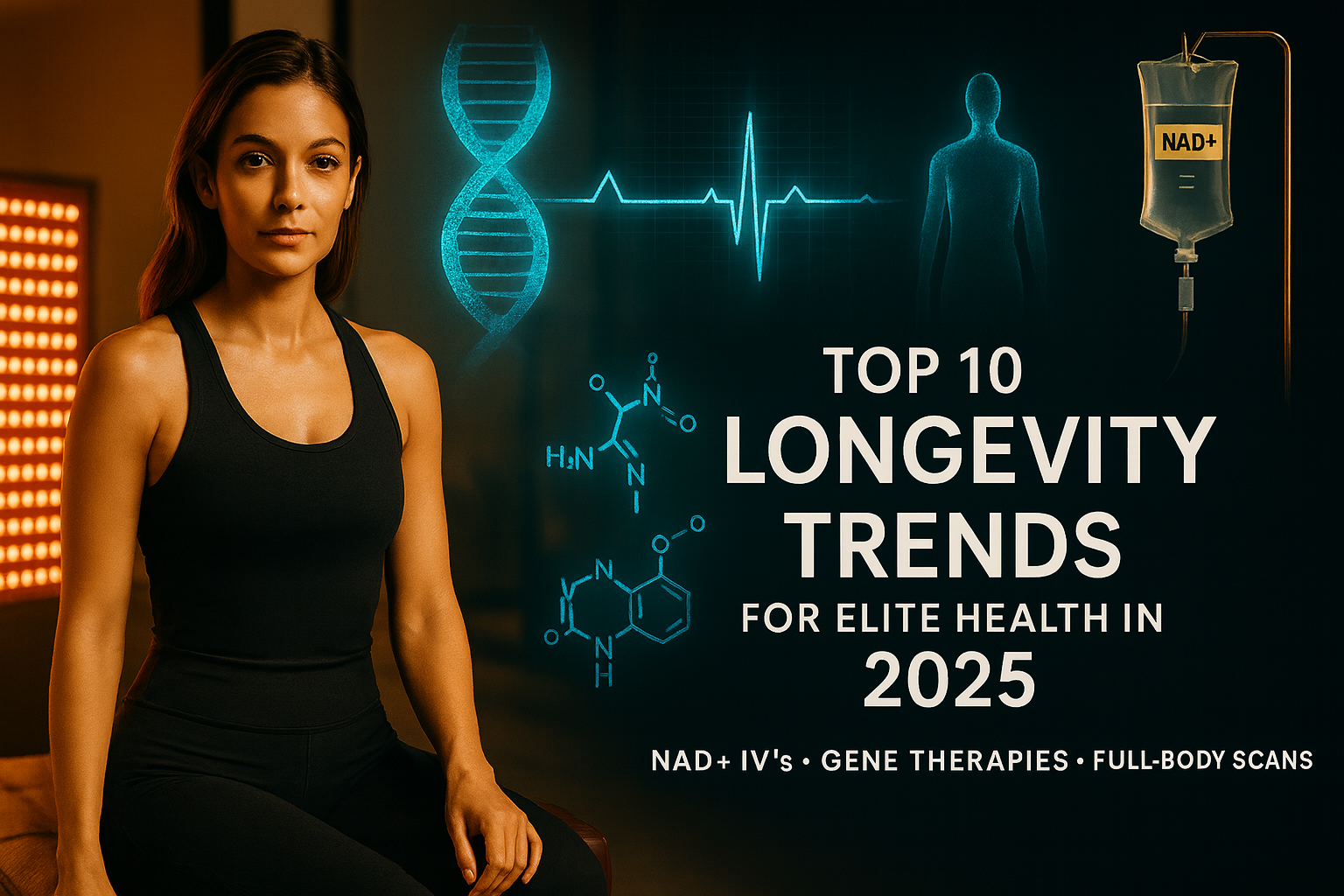Top 10 Longevity Trends for Elite Health in 2025: The Definitive Guide
2025 is a milestone year for performance-driven health. Precision diagnostics, regenerative modalities, and concierge care are converging into measurable healthspan strategies for affluent clients who want to look, feel, and perform at their best. The surging interest is no accident: the longevity marketplace—estimated around $19B in 2023—is widely reported to be on pace to triple to roughly $63B by 2035, reflecting a shift from “sick care” to proactive prevention and optimization.
This guide distills the most important, science-backed trends worth your attention—from NAD+ IV therapy and GLP-1–based metabolic resets to gene-level strategies, senolytics, and full-body imaging protocols. You’ll also see how our concierge medicine program aligns these tools into a single, accountable plan that meets your standards for privacy, service, and outcomes.
1) NAD+ IV Therapy for Cellular Energy & Recovery
NAD+ (nicotinamide adenine dinucleotide) fuels mitochondrial energy production, DNA repair, and sirtuin activity—systems that erode with age. Elite clients explore NAD+ IV protocols to rapidly raise circulating levels, often alongside oral precursors (NR, NMN) and lifestyle fundamentals. Reported benefits include steadier daytime energy, improved training recovery, and greater cognitive stamina.
Use it wisely: Our approach folds NAD+ into a structured stack: resistance training, sleep optimization, micronutrient repletion, and stress management. IV concentration, infusion rate, and frequency are individualized using history, labs, and tolerance. We avoid gray-market supply and document outcomes so any add-on earns its place.
2) Metabolic Rejuvenation with GLP-1s—Paired with Muscle-First Training
For those with obesity or cardiometabolic risk, GLP-1 and combination incretin therapies now deliver clinically meaningful weight loss and cardiovascular risk reduction. High-net-worth clients care about the composition of that weight loss, not just the number. That’s why our programs pair medication with progressive resistance training, protein targets, and DEXA-based body composition tracking to defend lean mass while improving metabolic markers.
Compliance and sourcing matter: We do not use counterfeit or informal compounded products. We coordinate with licensed prescribers and pharmacies, and we taper thoughtfully to preserve results without rebound.
3) Biological-Age Testing & Multi-Omic Panels
Traditional labs can miss early physiologic drift. In 2025, more clients are adding DNA methylation “clocks” and multi-omic panels (proteomics, metabolomics, microbiome) to track systems-level aging. The goal isn’t vanity metrics—it’s decision support. When epigenetic age, inflammatory tone, VO2 max, and strength converge, you can rationally decide where to invest next.
How we use it: We establish a baseline, then retest after a defined intervention window (usually 90–120 days). We never make treatment decisions on an epigenetic score alone; we integrate blood pressure, lipids, glycemic control, inflammation, body composition, and functional performance.
4) Liquid Biopsy for Early Cancer Signals (MCED)
Multi-cancer early detection (MCED) blood tests analyze cell-free DNA and other signals to raise flag(s) for further evaluation. They are adjunctive—not a replacement for guideline screenings (mammography, colonoscopy, Pap, LDCT for smokers). For appropriately counseled, risk-aware clients, MCED can be a useful layer, provided there’s a clear follow-up plan for positives to limit anxiety, radiation exposure, and unnecessary procedures.
Best practice: Use MCED within a coherent prevention protocol that also includes vaccines, lifestyle defenses, and organ-specific screening at evidence-based intervals.
5) Full-Body Scans: From “Celebrity MRI” to Targeted Imaging
Whole-body MRI has media allure, but professional societies emphasize the limited evidence in asymptomatic, average-risk people and the risk of incidental findings that drive costly cascades. Precision programs instead use targeted imaging—for example, Coronary Artery Calcium (CAC) scoring to refine cardiovascular risk stratification and personalize lipid-lowering strategies.
When imaging helps: Answer a specific question. Use standardized protocols. Pair results with action steps (e.g., LDL-C targets, antihypertensive therapy, nutrition and exercise prescriptions) and re-image only when it changes management.
6) Senolytics & Senotherapeutics
Senescent cells accumulate with age and secrete inflammatory molecules (the SASP) that disrupt tissue function. Senolytics aim to selectively eliminate these cells; senomorphics modulate their harmful secretions. The animal data are strong; human studies are early. We watch this area closely, but we don’t leap ahead of the clinical evidence.
What we do now: We reduce senescence drivers you control today—adiposity, inactivity, glycemic volatility, sleep debt, and chronic stress—while monitoring trial readouts for safe, clinically relevant protocols.
7) Gene Therapies & Partial Cellular Reprogramming
Frontier research targets aging at the programming layer—from myostatin inhibition (muscle) to partial reprogramming (transient expression of Yamanaka factors like OSK) to reset youthful gene expression patterns in tissues. Early indications are exciting in models, but human use for “anti-aging” remains largely investigational.
Our stance: Stay research-aware and risk-controlled. We do not endorse medical tourism or unregulated interventions. Where gene therapy is approved for specific diseases, we coordinate with appropriate specialists; otherwise we track trial data and prioritize safer, higher-yield levers (cardiometabolic control, strength, sleep, blood pressure, and lipids).
8) Hormone & Peptide Strategies—With Safety First
Optimizing hormones (thyroid, sex hormones, DHEA) can meaningfully improve quality of life when clinically indicated and monitored. Meanwhile, buzzworthy peptides (e.g., BPC-157, various secretagogues) remain a regulatory gray zone with inconsistent quality control.
Guardrails: We work inside medical guidelines, prescribe only when appropriate, and monitor for efficacy and safety. We do not source unapproved peptides online. Where evidence is still emerging, we discuss realistic effect sizes, cost, and exit criteria so you never chase a placebo.
9) Hyperbaric Oxygen & Light-Based Therapies
Hyperbaric Oxygen Therapy (HBOT) continues to generate interest for potential benefits in immune function, neurocognition, and cellular aging markers. Photobiomodulation (red/near-infrared light) has the strongest support in dermatology and tissue healing, with consumer-grade panels now common in luxury wellness spaces.
How to deploy: Treat these as adjuncts, not anchors. We prioritize cardiometabolic risk control, strength, sleep, and nutrition first, then layer HBOT or red light for specific goals with pre-defined metrics (e.g., wound healing endpoints, skin changes, or recovery markers).
10) The Longevity Tech Stack: Wearables, At-Home Testing & Continuous Care
Modern programs use wearables for sleep/activity/HRV, at-home labs, and AI-assisted insights to close the loop between behavior and biomarkers. Instead of annual checkups, you get continuous risk reduction: micro-adjustments to training blocks, nutrition, blood pressure control, or lipid therapy triggered by data—not guesswork.
Why it matters: The faster you detect drift (rising BP, creeping LDL-C, collapsing sleep), the cheaper and easier it is to correct. We convert raw feeds into weekly dashboards and quarterly objectives you can act on.
How Our Concierge Medicine Program Keeps Clients on the Cutting Edge
High performers don’t want a carousel of disjointed appointments. They want a single, accountable team to orchestrate the entire healthspan journey. Our concierge model aligns advanced diagnostics, evidence-based therapeutics, and lifestyle execution—and then wraps it in white-glove logistics.
Personalized Healthspan Programs (Designed Around You)
- High-resolution baselining: Advanced labs (inflammation, lipid subfractions, hormones), DEXA, targeted imaging (e.g., CAC when appropriate), sleep evaluation, and biological-age testing.
- Precision therapeutics: When appropriate—GLP-1s for cardiometabolic risk, monitored NAD+ IVs, carefully managed hormone therapy, and vetted adjuncts (HBOT, red-light) inside a coherent plan.
- Practice-level guardrails: No gray-market peptides, no unregulated “gene hacks,” no off-label detours without a written risk/benefit pathway and informed consent.
- Continuous monitoring: Wearable-driven insights, remote vitals, and outcome dashboards that tie behaviors to biomarkers.
Integration matters: We sequence the right actions, at the right time, with the right oversight—so you’re not “trying everything,” you’re compounding advantages.
Explore Concierge Medicine or Schedule a Consultation to design a healthspan plan calibrated to your lifestyle.
Learn More | Schedule a Consultation
Your 2025 Longevity Playbook: What to Start, What to Skip
Start (or Double-Down On)
- Strength + muscle: Progressive resistance training, protein targets, and creatine (if appropriate) remain the most reliable “youth serum” for metabolism, mobility, and aesthetics.
- Cardiometabolic prevention: Optimize blood pressure, LDL-C, A1c, and inflammation. Consider CAC scoring when clinically indicated to personalize risk and therapy intensity.
- Sleep as strategy: Aim for consistency, curb late alcohol, and screen for sleep apnea if snoring/daytime fatigue are present.
- Sauna & cold (prudently): Use as recovery tools; integrate safely with cardiovascular status and hydration.
- Guideline-based cancer screening: Add MCED judiciously if you and your physician agree it fits your risk profile and psychology.
Be Cautious With
- Full-body MRI “just to see”: We prefer targeted imaging tied to an actionable decision.
- Unapproved peptides or informally compounded incretins: Source only through regulated channels with appropriate follow-up.
- Hype-driven “biohacks” without metrics: Demand a rationale, a realistic effect size, and a way to measure success within 90 days.
Think Like an Investor
In longevity, sequence beats scattershot. Fund the pillars first (muscle, metabolic health, sleep, blood pressure, LDL-C). Then layer targeted innovations—NAD+ IVs, photobiomodulation, HBOT—only when they fit your clinical picture and you can measure the delta. For frontier modalities (senolytics, partial reprogramming), track the pipeline with your medical team and wait for protocols that deliver meaningful, safe effect sizes.
A 90-Day Implementation Blueprint
To eliminate decision fatigue, we onboard clients through a tight 90-day sequence:
- Weeks 0–2: Baseline & Goal Map — Intake, labs, body comp, sleep screen, targeted imaging if indicated, and a lifestyle audit. Define a 12-month vision with quarterly milestones.
- Weeks 3–6: Pillars Online — Training block (strength + conditioning), nutrition targets, sleep plan, BP and lipid strategy, and compliance coaching. Add NAD+ or GLP-1s only when medically indicated.
- Weeks 7–10: Personalization — Titrate meds, iterate macros, layer adjuncts (HBOT/red-light) if they fit goals, and set objective markers (resting HR, HRV trends, DEXA delta, lab shifts).
- Weeks 11–12: Review & Quarter-Two Plan — Compare data to targets, adjust, and set next-quarter objectives. Decide if additional diagnostics (epigenetic clocks, MCED) are warranted.
Throughout, you’ll have a single point of contact, coordinated scheduling (including mobile services), and a private dashboard that translates data into action. The outcome is clarity, not clutter.
What This Means for Affluent, Performance-Driven Clients
Longevity is no longer about chasing the newest gadget. It’s an operating system—prevention, performance, and aesthetic edge—implemented by a team that knows you and is accountable for outcomes. When your plan is sequenced and data-driven, you get compounding returns: better labs, higher energy, stronger physique, clearer skin, and fewer false alarms.
Ready to move? View Concierge Medicine Plans or Schedule a Consultation. If you want an overview first, Learn More.
References
- San Francisco Chronicle — Reporting on the growing longevity marketplace
- American College of Radiology — Position on screening whole-body MRI
- New England Journal of Medicine — Cardiovascular outcomes with GLP-1 therapy
- American Cancer Society — Multi-cancer early detection (MCED) overview
- Nature Reviews — Senolytics and senotherapeutics in aging
- Nature Communications — Partial cellular reprogramming research

